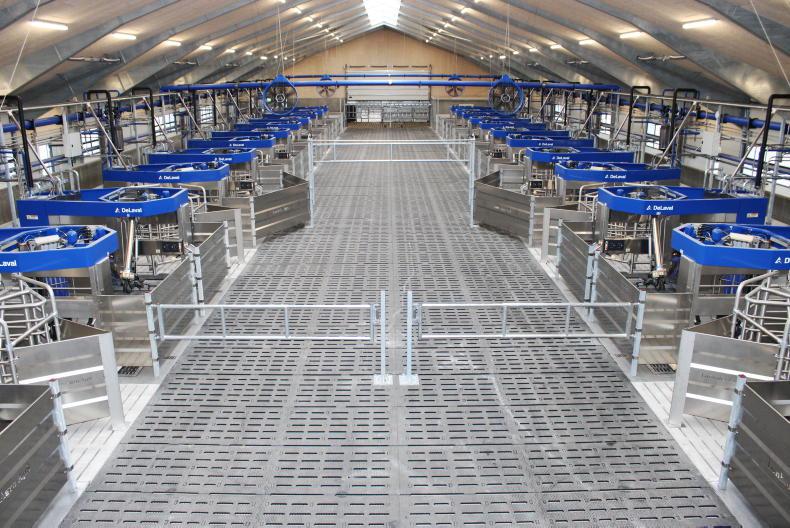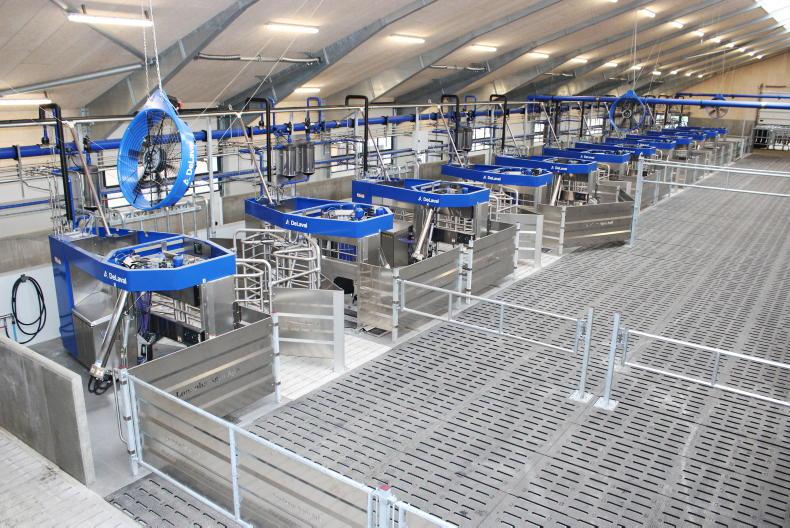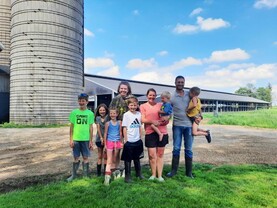A new type of milking system was launched in Denmark last week as DeLaval unveiled its largest robotic batch milking setup in the world.
Robotic milking systems are well proven: the cow comes to the robot voluntarily, is milked and is then let back to the shed or to the field. Conventional milking systems involve bringing all of the cows in together to be milked, either in a herringbone or rotary parlour.
Robotic batch milking involves combining the advantages of both systems – not having to physically attach clusters, while at the same time having a predictable system ensuring that all cows are milked and having a defined milking period.
Dairy farmer Klaus Jakobsen is milking 830 cows near Kolding in central Denmark.
He took over the farm in 2019 and has set about a major expansion programme, building a new barn to accommodate extra cows with plans to milk 1,400 cows in the future.

Danish dairy farmer Klaus Jakobson has installed the first DeLaval batch robotic milking system in northern Europe
The existing milking facilities, a 12-unit double was taking two people to milk 80 cows per hour, so if the farm was to expand, a new parlour was needed.
In a well-developed economy like Denmark, labour is scarce and getting harder to find. Eastern European workers used to make up a high proportion of the workforce on Danish farms but that is no longer the case as employment opportunities are better in these countries.
An increasing number of employees on Danish farms are from India or Thailand. Some farmers are asking where they are going to go next to seek employees.
Another important point is that employees in Denmark are not permitted to work more than 37 hours per week. If they exceed this, they need to be paid overtime but it is against the law to pay overtime in two consecutive periods.
With labour shortages in mind, Klaus said he wanted a facility that was going to help reduce labour requirements. Discussions centred on a large rotary or a robotic system.

A new cow barn has also been built and Klaus plans to increase cow numbers to 1,400 Jerseys.
The end result was 24 DeLaval VMS robots installed into a slatted collecting yard with 12 on either side. Cows are kept in groups of 180 in a nearby cubicle shed and brought to the milking area for milking twice a day. The cows then select what robot they want to go into for milking.
A small amount of meal entices them into the robot. After milking, they walk out of the robot and into an alleyway that brings them back to the shed through a separation or drafting gate.
Any cow that needs attention is drafted into a holding pen.
It has been taking about one hour to milk the 180 cows but Klaus says this is speeding up the whole time and expects the system to be milking 200 cows per hour in another few months.
The robots were turned on at the end of May, so the system has only been going for three months. The cows on the Jakobsen farm are purebred Jersey, so milking times are less compared to higher yielding Holstein Friesian.

The new DeLaval batch robotic milking setup on Klaus Jakobson's farm in Denmark.
While the cows are being milked, the operator is cleaning any dung off the sand bedded cubicles, scraping crossovers and doing any other jobs that need to be done.
The first cows are back in the shed 10 minutes after entering the milking area. Another employee feeds out fresh total mixed ration (TMR) while the cows are being milked which Klaus says has been a help at cow flow.
Milking time is currently taking over four hours per session but Klaus expects this to settle at around six and a half hours per milking when the farm is finished expanding.
Not all 1,400 cows will be in milk at any one time as the herd is calving all year round.
“We currently have eight people working on the farm, which seems high, but the old milking facility was only shut down recently and this is being taken down and extra cow housing installed, so we are doing a lot of this work ourselves.
“When the farm is finished expanding, I believe we will still have eight employees with a maximum of two people involved in milking and that will really only involve moving cows to the milking area and cleaning cubicles, so it won’t be as mundane as just putting on clusters for six or seven hours a shift,” Klaus told the Irish Farmers Journal.
When most of the cows are milked, the operator pushes the remaining cows to the top half of the milking area and then lets in another bunch of 180 cows.
Cows from different groups can mix before or after being milked as they will be drafted back to their correct group by the separation gates located at the end of the alleyway on the way back from milking.
The total cost of the facility was not disclosed but, according to DeLaval, each milking station is its own independent robot with little or no common or shared equipment between all 24 robots.
Klaus did say that he opted not to buy a touchscreen controller for each robot and instead uses a mobile app to control the robot.

There are 12 DeLaval robots on either side of the milking area.
Essentially, the cost of the setup equals the cost of purchasing 24 DeLaval VMS robots plus the buildings for housing them.
DeLaval says that one of the advantages of keeping each robot independent is that if one breaks down or needs servicing, then the rest will continue to function.
OK, I don’t see too many Irish dairy farmers investing in a batch milking facility such as the one featured here.
But, for me, it does highlight the direction of travel that milking technology is going in.
I put it to some of the DeLaval people that there is huge scope to take out costs and make batch robotic milking a more affordable option for lower-cost farmers.
For example, why can’t vacuum pumps, milk pumps, plate coolers, milk lines and even central processing units all be shared by the robots?
Grass-based farmers don’t require or value the same level of data or reports that robots issue, so maybe there is scope to reduce some of the software costs too.
Even at that, there will still be a significant premium to be paid over and above conventional milking or voluntary robot milking for a batch robot system.
Twelve units would be needed to milk 100 cows per hour. The trade-off will be higher capital cost versus much lower labour input. It will be interesting to watch developments.
A new type of milking system was launched in Denmark last week as DeLaval unveiled its largest robotic batch milking setup in the world.
Robotic milking systems are well proven: the cow comes to the robot voluntarily, is milked and is then let back to the shed or to the field. Conventional milking systems involve bringing all of the cows in together to be milked, either in a herringbone or rotary parlour.
Robotic batch milking involves combining the advantages of both systems – not having to physically attach clusters, while at the same time having a predictable system ensuring that all cows are milked and having a defined milking period.
Dairy farmer Klaus Jakobsen is milking 830 cows near Kolding in central Denmark.
He took over the farm in 2019 and has set about a major expansion programme, building a new barn to accommodate extra cows with plans to milk 1,400 cows in the future.

Danish dairy farmer Klaus Jakobson has installed the first DeLaval batch robotic milking system in northern Europe
The existing milking facilities, a 12-unit double was taking two people to milk 80 cows per hour, so if the farm was to expand, a new parlour was needed.
In a well-developed economy like Denmark, labour is scarce and getting harder to find. Eastern European workers used to make up a high proportion of the workforce on Danish farms but that is no longer the case as employment opportunities are better in these countries.
An increasing number of employees on Danish farms are from India or Thailand. Some farmers are asking where they are going to go next to seek employees.
Another important point is that employees in Denmark are not permitted to work more than 37 hours per week. If they exceed this, they need to be paid overtime but it is against the law to pay overtime in two consecutive periods.
With labour shortages in mind, Klaus said he wanted a facility that was going to help reduce labour requirements. Discussions centred on a large rotary or a robotic system.

A new cow barn has also been built and Klaus plans to increase cow numbers to 1,400 Jerseys.
The end result was 24 DeLaval VMS robots installed into a slatted collecting yard with 12 on either side. Cows are kept in groups of 180 in a nearby cubicle shed and brought to the milking area for milking twice a day. The cows then select what robot they want to go into for milking.
A small amount of meal entices them into the robot. After milking, they walk out of the robot and into an alleyway that brings them back to the shed through a separation or drafting gate.
Any cow that needs attention is drafted into a holding pen.
It has been taking about one hour to milk the 180 cows but Klaus says this is speeding up the whole time and expects the system to be milking 200 cows per hour in another few months.
The robots were turned on at the end of May, so the system has only been going for three months. The cows on the Jakobsen farm are purebred Jersey, so milking times are less compared to higher yielding Holstein Friesian.

The new DeLaval batch robotic milking setup on Klaus Jakobson's farm in Denmark.
While the cows are being milked, the operator is cleaning any dung off the sand bedded cubicles, scraping crossovers and doing any other jobs that need to be done.
The first cows are back in the shed 10 minutes after entering the milking area. Another employee feeds out fresh total mixed ration (TMR) while the cows are being milked which Klaus says has been a help at cow flow.
Milking time is currently taking over four hours per session but Klaus expects this to settle at around six and a half hours per milking when the farm is finished expanding.
Not all 1,400 cows will be in milk at any one time as the herd is calving all year round.
“We currently have eight people working on the farm, which seems high, but the old milking facility was only shut down recently and this is being taken down and extra cow housing installed, so we are doing a lot of this work ourselves.
“When the farm is finished expanding, I believe we will still have eight employees with a maximum of two people involved in milking and that will really only involve moving cows to the milking area and cleaning cubicles, so it won’t be as mundane as just putting on clusters for six or seven hours a shift,” Klaus told the Irish Farmers Journal.
When most of the cows are milked, the operator pushes the remaining cows to the top half of the milking area and then lets in another bunch of 180 cows.
Cows from different groups can mix before or after being milked as they will be drafted back to their correct group by the separation gates located at the end of the alleyway on the way back from milking.
The total cost of the facility was not disclosed but, according to DeLaval, each milking station is its own independent robot with little or no common or shared equipment between all 24 robots.
Klaus did say that he opted not to buy a touchscreen controller for each robot and instead uses a mobile app to control the robot.

There are 12 DeLaval robots on either side of the milking area.
Essentially, the cost of the setup equals the cost of purchasing 24 DeLaval VMS robots plus the buildings for housing them.
DeLaval says that one of the advantages of keeping each robot independent is that if one breaks down or needs servicing, then the rest will continue to function.
OK, I don’t see too many Irish dairy farmers investing in a batch milking facility such as the one featured here.
But, for me, it does highlight the direction of travel that milking technology is going in.
I put it to some of the DeLaval people that there is huge scope to take out costs and make batch robotic milking a more affordable option for lower-cost farmers.
For example, why can’t vacuum pumps, milk pumps, plate coolers, milk lines and even central processing units all be shared by the robots?
Grass-based farmers don’t require or value the same level of data or reports that robots issue, so maybe there is scope to reduce some of the software costs too.
Even at that, there will still be a significant premium to be paid over and above conventional milking or voluntary robot milking for a batch robot system.
Twelve units would be needed to milk 100 cows per hour. The trade-off will be higher capital cost versus much lower labour input. It will be interesting to watch developments.










 This is a subscriber-only article
This is a subscriber-only article










SHARING OPTIONS: